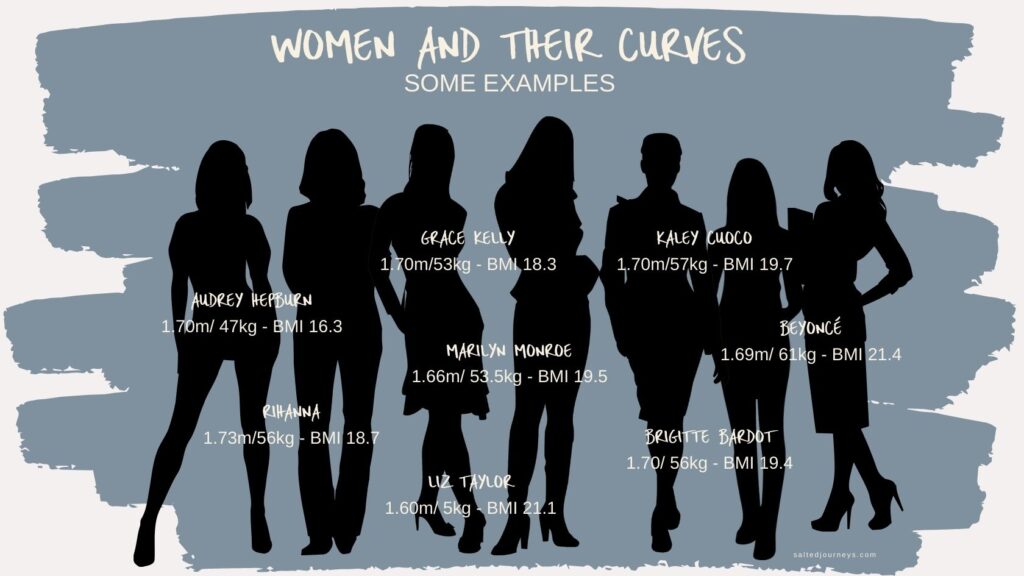Marilyn Monroe, Body Positivity & Fat Acceptance
Everyone should accept and like themselves. This is clear. No one should be discriminated against or treated differently because of their appearance.
It also shouldn’t be used as an excuse for not achieving the goals you’ve more or less obviously set for yourself. There is only one thing at stake here: health.
There are enough studies that show that a BMI that is too high is detrimental to your health. This happens now, but at the latest in old age, when you need assistance with daily activities or when you are more prone to serious illnesses because your organs are overloaded with fat.
The problem with “Fat Acceptance”
The problem with this is that “fat ” falls on fertile ground in view of the fact that there is now a high rate of overweight people in most countries and, for example, the majority in Germany is now overweight, and is superficially very positive, because it is about something good: preventing shame and discrimination and helping overweight people.
Ultimately, however, this “help” leads to people being persuaded that there is nothing they can do about their obesity. In the case of “alcohol acceptance” or “nicotine acceptance”, most people would probably recognize the problem immediately, although the reasons could even be similar.
There is a genetic predisposition to addiction and relapse rates are very high.
A central argument of fat acceptance is also the “95% relapse rate” for diets, although these figures are simply not true.
But all this serves to make people resign themselves and ultimately accept that they have to be fat forever.
In addition, many people continue to claim that women “back then” had curves, that they were not the “rattles” of today’s celebrities. So why should anyone shame the people who are “just” like the sexbombs in the past?
But is this true? Let’s look at some examples.
The BMI as a measure indicates a range of normal weight between 18.5 and 24.9.

So why are these women called “full women” or not “slim women”?
It’s the proportions. An averagely overweight figure that has a little too much “over” everywhere and is not genetically determined, especially in the buttocks and breasts, would certainly not be described as classically sexy by the men of creation.
So, no, these women were not overweight, although some of them were very thin. But their curves were a sign of sexiness and beauty, now and then.
Read more about
-
Best of Mealprepping Hacks for a Weekend Oh, we all love hacks AND snacks.So here are the best mealprepping hacks for a surf weekend with good foods […]
-
Creating a Pre-Surf Ritual: Breathing, Meditation, and Visualization Breathing, Meditation, and Visualization Surfing—the ultimate blend of adrenaline, saltwater therapy, and trying not to embarrass yourself in front of […]
-
Surfing in Harmony with Nature Respecting and protecting the coasts:Do something on your next Surfing Adventure abroad Find out how you can actively contribute to […]
-
The ultimate Equipment List for your Surf Camping Van Who doesn't dream of having their own camping van to visit the best places in the world to go surfing? […]
-
TO GO – Healthy Snack Ideas for your next Surftrip To feel good, refreshed and fit, every surf girlneeds a tasty and healthy snack for the next trip On the […]
-
Mindfulness Hacks for Surfers I know. "Hacks" and "Mindfulness don't goso well together. But we all like all kind of hacks, they sound like […]
-
From the Waves to the Screens – Series Series And here are a few more surfing series worth watching on the subject: 1. “Surviving Summer” (2022) The series […]
-
From the Waves to the Screens – Movies Movies Here's a nice list for you of inspiring surf movies that focus on female protagonists or themes. These films […]
-
Training ashore for Surfers – An Overview Training ashore for Surfers or: How to stay fit for Surfing What if you live in the driest part of […]
-
Surfing for Mental Health Surfing for Mental Healthor: How to use Surfing for a peaceful Mind Surfing can be an incredible outlet for improving […]
-
Why not to be fat – reasons you never thought about Why not to be fat – reasons you never thought about Let's get it straight. Most people want a slim […]
-
Your next fancy Fitness Gadget Sometimes it's just fun to buy something new(if you just won some small lottery) … whether it's really necessary or […]
